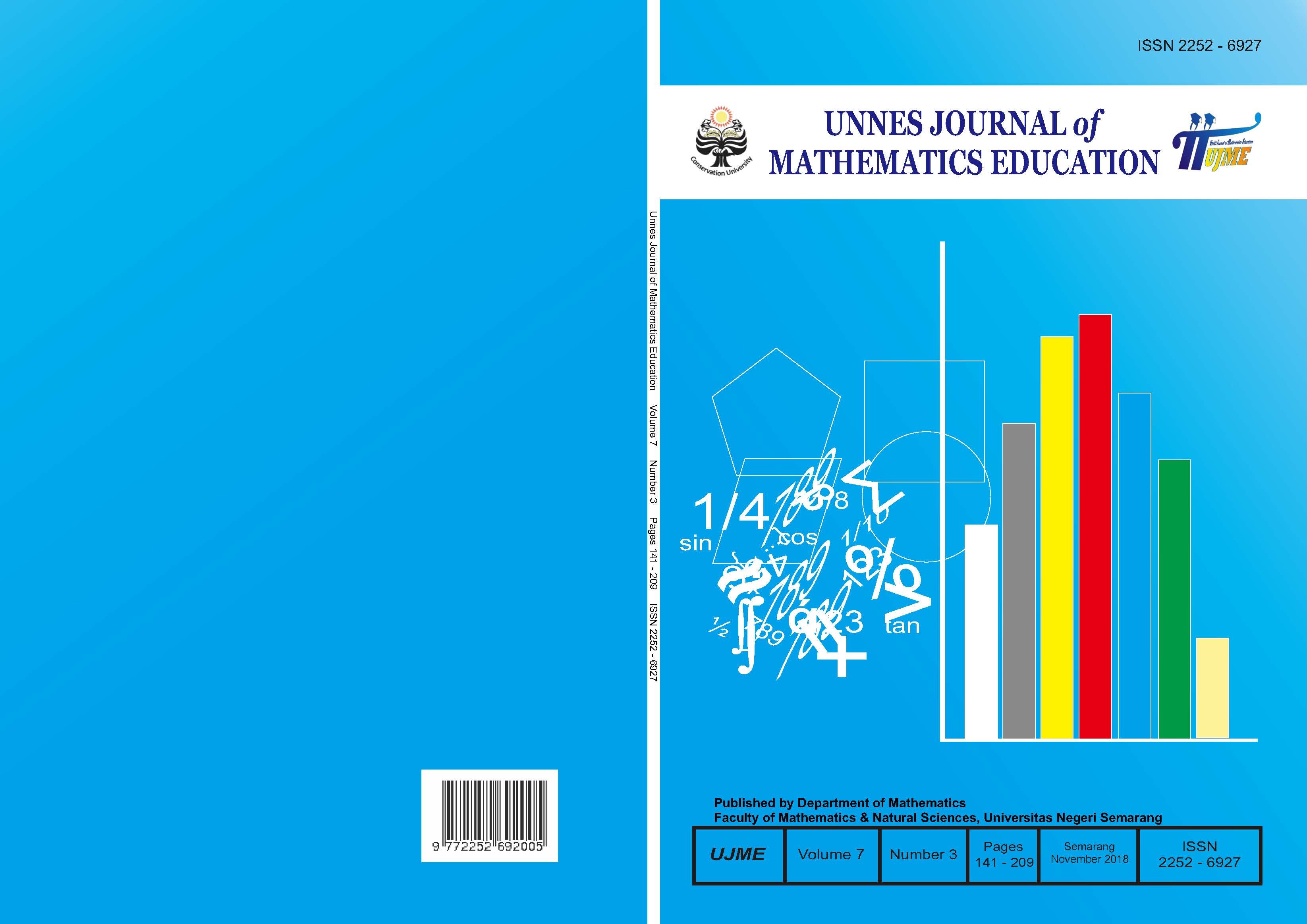The analysis of students’ mathematical connection ability and responsibility in two stay two stray learning with problem cards
##plugins.themes.academic_pro.article.main##
Abstract
This research aims to discover mathematics learning on Two Stay Two Stray (TSTS) learning assisted by effective problem cards on students' mathematical connection abilities, describing students' mathematical connection skills based on responsibility for TSTS learning and describing students' responsibilities in TSTS learning. The method used in this research is a mixed method. The population in this research were students of class VII A - VII B on one of junior high schools in Semarang, based on random sampling technique, it was selected that class VII A as the experimental class and class VII B as the control class. The results of the research show that; Students 'mathematical connection ability by using the TSTS model can reach KKM (minimum criteria of mastery learning) and classical completeness, the mathematical connection ability of students by using TSTS learning is better than students' mathematical connection skills by using expository learning. (3) Subjects with high responsibility were able to achieve three indicators of mathematical connection ability well, subjects with moderate responsibility have differences in achieving mathematical connection indicators, subjects with low responsibility were able to achieve one of mathematical connection indicator.
##plugins.themes.academic_pro.article.details##
References
Azwar, S. 2015. Penyusunan Skala Psikologi Edisi 2. Yogyakarta: Pustaka Belajar
Baki, A., Çatlıoğlu, H., Coştu, S., & Birgin, O. 2009. Conceptions of high school students about mathematical connections to the real-life. Procedia-Social and Behavioral Sciences, 1(1), 1402-1407.
Creswell John.W. 2014. Penelitian Kualitatif & Desain Riset. Yogyakarta : Pustaka Pelajar
Depdiknas. 2006. Permendiknas No 22 Tahun 2006 Tentang Standar Isi. Jakarta : Depdiknas.
Hendriana, H., Slamet, U. R., & Sumarmo, U. 2014. Mathematical Connection Ability and Self-Confidence (An Experiment on Junior High School students through Contextual Teaching and Learning with Mathematical Manipulative). International Journal of Education, 8(1), 1-11.
Jaijan, W. & Loipha, S. 2012. Making Mathematical Connections with Transformations Using Open Aproach. HRD Journal, 3(1): 91 -100.
Lie, A. 2010. Cooperative Learning, Mempraktikkan Cooperative Learning di Ruang-Ruang Kelas. Jakarta: Grasindo.
Maulana. 2011. Dasar-dasar Keilmuan dan Pembelajaran Matematika Squel 1. Subang: Royyan Press
Mhlolo, M. K., Venkat, H., & Schäfer, M. (2012). The nature and quality of the mathematical connections teachers make. Pythagoras, 33(1)
Miftachudin, Budiyono, & Riyadi. 2015. Efektivitas Model Pembelajaran Two Stay Two Stray dengan Tutor Sebaya dalam Pembelajaran Matematika pada Materi Bangun Datar Ditinjau dari Kecerdasan Majemuk Peserta Didik Kelas VII SMP Negeri di Kebumen Tahun Pelajaran 2013/2014. Jurnal Elektronik Pembelajaran Matematika, 3(3), 233-241.
NCTM. 2000. Principles and Standards for School Mathematics. Amerika: The National Council of Teachers of Mathematics. Inc.
Organisation for Economic Co-operation and Development. 2016. PISA 2015 Results in Focus. New York: Columbia City
Provasnik, S., D. Kastberg, D. Ferraro, N. Lemanski, S. Roey, & F. Jenkins. 2016. Highlights From TIMSS and TIMSS Advanced 2015: Mathematics and Science Achievement of U.S. Students in Grades 4 and 8 and in Advanced Courses at the End of High School in an International Context. Washington DC: National Center for Education Statistics, Institute of Education Sciences, U.S. Department of Education.
Sugiyono. 2012. Metode Penelitian Kombinasi (Mixed Methods). Bandung: Alfabeta.
Sugiyono. 2016. Metode Penelitian Kuantitatif, Kualitatif dan R&D. Bandung: PT Alfabeta.
Trianto. 2011. Mendesain Model Pembelajaran Inovatif Progresif: Konsep, Landasan, dan Implementasinya pada Kurikulum Tingkat Satuan Pendidikan (KTSP). Jakarta: Bumi Aksara.
Wardhani, I. Y., Sajidan, S., & Maridi, M. (2012). Penerapan Model Pembelajaran Kooperatif Tipe Two Stay Two Stray Disertai Media Audio-Visual untuk Meningkatkan Kualitas Pembelajaran Biologi Siswa Kelas XI IPA 5 SMA Negeri 7 Surakarta Tahun Pelajaran 2011/2012. Pendidikan Biologi, 4(1).
